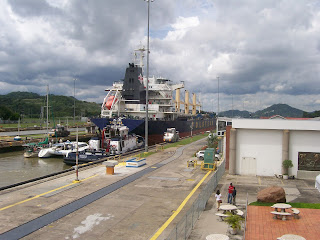Post No. 25. The Panama Canal
The Panama Canal has proven to be a demonstration of human
ingenuity in challenging nature and achieving the dream of connecting the Atlantic and Pacific oceans. The Project was achieved
through the extensive use of technology and efficient management and the work of
hundreds of workers from many parts of the world, including the personnel who
came to work from the West Indies . Many years have passed since that May 6, 1904
when he was appointed the first Chief Engineer to start work, infrastructure
and sanitation. More than 75,000 men and women worked n the Canal in total and
after 32 years of intense work the Canal was officially opened on August 15,
1914 with an estimated 28,000 workers death and 5609 during the U.S. Panama
Canal remains in force and at the service of humanity. (author)
The Panama Canal is an artificial 77 Km (48 miles) waterway
in Panama that connects the
Atlantic Ocean with the Pacific Ocean . The
canal cuts across the Isthmus of Panama and is
a key conduit for international maritime trade. There are locks at each end to
lift ships up to Gatun
Lake
The earliest mention of a canal across the Isthmus of Panama dates back to 1534, when Charles V, Holy Roman Emperor and King of Spain, ordered a survey for a route through the
The United
States
The construction of a canal with locks required the
excavation of more than 170,000,000 cu yd ( 130,000,000) of material over and above
the 30,000,000 cu yd (23,000 cubic meters) excavated by the French. As quickly
as possible, the Americans replaced or upgraded the old, unusable French
equipment with new construction equipment that was designed for a much larger
and faster scale of work. About 102 new large, railroad-mounted steam shovels
were purchased from the Marion Power Shovel Company and brought from the United States Gatun Lake flooded over the original rail line, and a new
line had to be constructed above Gatun
Lake
On 1904, John Frank Stevens, a self-educated engineer who had built the Great Northern Railroad was appointed as Chief engineer of the Panama Canal Project.
One of Steven’s first achievements in
Colonel William C. Gorgas had been appointed chief sanitation
officer of the canal construction project in 1904. Gorgas implemented a range
of measures to minimize the spread of deadly diseases, particularly yellow
fever and malaria which had recently been shown to be mosquito-borne following
the work of Dr. Carlos Finlay and Dr. Walter Reed. There was investment in
extensive sanitation projects, including city water systems, fumigation of
buildings, spraying of insect- breeding areas with oil and larvicide,
installation of mosquito netting and window screens, and elimination of
stagnant water. After two years of extensive work, the mosquito-spread diseases
were nearly eliminated. Nevertheless, even with all this effort, about 5,600
workers died of disease and accidents during the U.S.
In 1907, U.S. President Theodore Roosevelt appointed U.S.
Army Major George Washington Goethals of the U.S. Army Corps of Engineers
(later promoted to General), a strong, United States Military Academy- trained
leader and civil engineer with experience of canals. Goethals would direct the
work in Panama
He divided the engineering and excavation work into three
divisions: Atlantic , Central, and Pacific. The
Atlantic Division, under Major William L. Sibert, was responsible for
construction of the massive breakwater (structures constructed on coasts as
part of coastal management [defense against flooding and erosion, and
techniques that stop erosion to claim lands] or to protect an anchorage from
the effects of both weather and longshore drift.], the Gatun locks (lock system
that lifts a ship up 85 feet [26 meters] to the main elevation of the Panama
Canal and down again. The original canal had a total of six steps [three up, three
down] for a ship’s passage. The total length of the lock structures, including
the approach walls, is over 1.9 miles {3 k}. The locks were one of the greatest
engineering works ever to be undertaken when they opened in 1914. No other
concrete construction of comparable size was undertaken until the Hoover Dam,
in the 1930s) and their 3½ mi (5.6 km) approach channel, and the immense Gatun
Dam. The Pacific Division, under Sydney B. Williamson (the only civilian member
of this high-level team), was similarly responsible for the Pacific 3 mi (4.8
km) breakwater in Panama Bay, the approach channel to the locks, and the
Miraflores and Pedro Miguel locks and their associated dams and reservoirs. ²
The Central Division, under Major David du Bose Gaillard of
the United States Army Corps of Engineers, was assigned one of the most
difficult parts: excavating the Culebra Cut through the continental divide to
connect Gatun Lake to the Pacific Panama Canal locks. ²
On October 10, 1913, President Woodrow Wilson sent a signal
from the White House by telegraph which triggered the explosion that destroyed
the Gamboa Dike. This flooded the Culebra Cut,thereby joining the Atlantic and pacific Oceans. ²
By the 1930s it was seen that water supply would be an issue
for the canal; this prompted the building of the Madden Dam across the Chagres River
above Gatun Lake Madden Lake
(later Alajuela Lake United
States
While globally the Atlantic Ocean is east of the isthmus and
the Pacific is west, the general direction of the canal passage from the Atlantic to the Pacific is from northwest to southeast. ²
References:
² Wikipedia.
The Panama Canal: Documentary on the Construction of the Panama Canal (Full Documentary). Time: 1:23:39:
Experience Panama-
Megastructures Panama Canal by National
Geographic. Time: 47:00:
How the Panama Canal was
built-BBC News. Time: 2:00:
The Panama Canal ’s New
Expansion, Explained. Time: 2:13:
Building the Panama Canal
and how does it work [Full Documentary]. Time: 2:05:29:




Personal photo. It was taken during my recent visit to the Panama Canal.
ReplyDelete